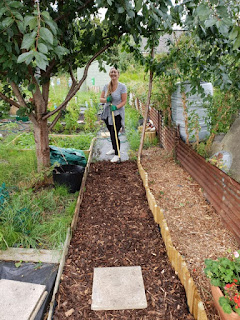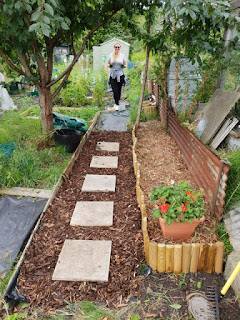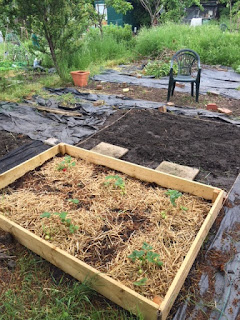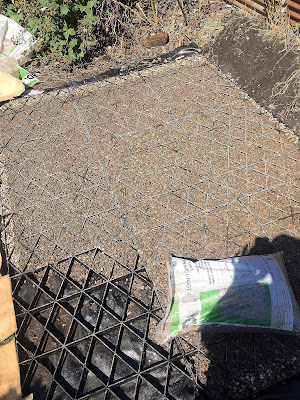I LOVE allotment and gardening books, even those that aren't particularly helpful or well-written. I find them incredibly relaxing to read, and can often be found flicking through them at the end of a long, tiring, stressful day.
I have a pretty sizable collection already, despite only starting to take an interest in gardening and growing in the past year. These are just a few of the books I own, but there are many more scattered about the house:
With the internet being such a valuable source of gardening and growing information, I originally thought I wouldn't find books that helpful. However, as a complete beginner, I found it useful to have a few reliable sources to refer to, rather than wading through the often confusing and conflicting information online.
Some of the books I own are reliable favourites I return to again and again. Others...less so. I bought several books very cheaply via eBay and some of them are poor to say the least. Patronising, not particularly helpful, and surprisingly sexist in some cases, despite being published fairly recently. This post will concentrate on the books I've found most helpful, however.
In no particular order, these are the books I would recommend to a novice allotmenteer or someone looking to start growing fruit or veg at home for the first time:
Allotment Month by Month: How to Grow Your Own Fruit and Veg
Alan Buckingham
Allotment Month by Month was the first book I bought when we took on our plot, and it was incredibly helpful. It's very clearly and attractively laid out and I love that it's separated into months so you can see at a glance what you should be doing at any given time! Due to the sheer volume of topics it covers, it doesn't go into a great deal of depth, but as an overview for newbie growers, I think it's one of the best books out there.
It has an extensive section on many of the most commonly grown allotment crops, with some useful tips on sowing, growing and harvesting. The book is laid out similarly to a very helpful textbook, and feature attractive photos to boot. If you only buy one book, make it this one!
RHS Allotment Handbook & Planner: What to do when to get the most from your plot
The Royal Horticultural Society
The second book I purchased after signing up for my plot, the
RHS Allotment Handbook & Planner is another one I found extremely useful. The advice is pretty thorough and the book has a similar textbook feel to Allotment Month by Month. As you might expect from the RHS, it's a well put together book with some stunning photos. There are sections on just about anything you can think of when it comes to allotments, including keeping chickens and which insects are particularly beneficial to your plot.
I tend to use this book as an introduction to various techniques and then head over to the RHS website if I need more in-depth info. There is a fantastic
grow your own section, and I can get lost on this website for hours if I'm not careful!
The Veg Grower's Almanac: Month by Month Planning and Planting
Martyn Cox
I received this as a gift for Christmas and I didn't think I'd get much use out of it as I already had a few other books by then. However,
The Veg Grower's Almanac is a fascinating little book. Perfect for reading in bed (or while taking a break down on the plot at allotment 22!) due to its more compact size in relation to most of my other allotment books, it's a goldmine of info. It takes a different approach to the other two books above, and contains interesting nuggets of information you wouldn't usually find in a a gardening book. There are sections on the history of various plants, tips on growing more unusual crops and some genuinely entertaining facts on all things fruit and veg.
I didn't actually realise this was a
Gardener's World publication until I picked it up just now to flick through it, but it's slightly more informal and conversational style makes sense now I know this.
Practical Allotments
Paul Wagland
I picked up
Practical Allotments at a local garden centre not long after we'd taken on our plot. At that point, I was so hungry for tips and advice, I was pretty much snapping up everything with the word "allotment" on it. This turned out to be a pretty useful purchase, however. Not so much for growing advice - although there is some of that in here - but more in terms of inspiration for laying out and managing the plot. While there are things I am simply never even going to contemplate - such as installing solar panels on my shed - there are some handy tips for adding a seating area, building your own compost bin, saving seeds and lots of other practical things.
I'd say this book is particularly suited to anyone who's inherited a particularly crap plot, that is, one with no usable structures or one that needs a complete overhaul to make it work efficiently. If you have been lucky enough to land a well-maintained plot with shed, greenhouse, immaculate fencing and pristine beds, this probably won't be quite as useful!
So there are my favourite books out of the 20 or so I've accumulated in the past year. That isn't to say the others aren't useful or I don't enjoy reading them, just that those listed above are the ones I return to most frequently and the ones I've found most consistently helpful.
Please let me know if you've read any allotment or gardening books you loved, or if you've read any of those mentioned above!
Jenny x


















































